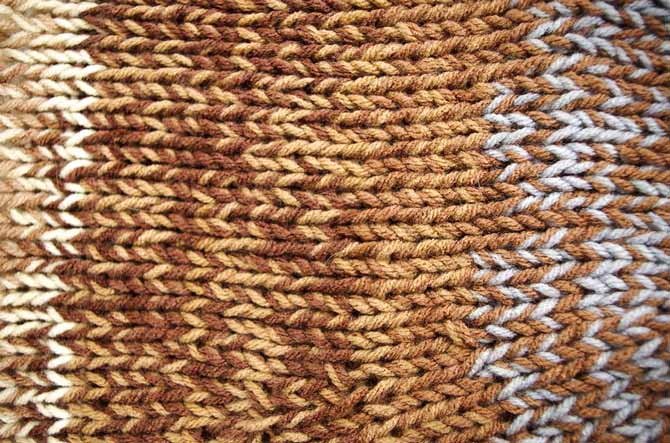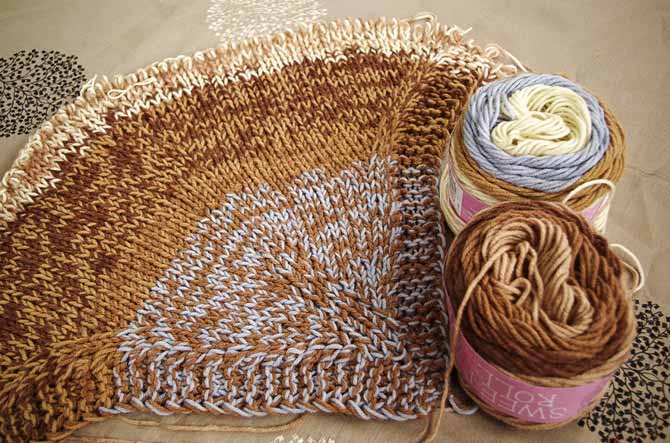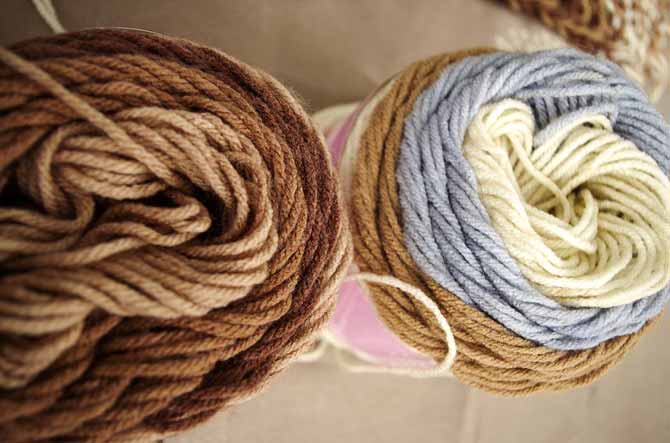Self-striping yarn became popular with the quick growth, almost a movement, in sock knitting. Gradient yarns have become popular with the development of shawls and stoles and their visibility in the knitting community. Yesterday, I worked with one colorway to create stripes. This whole week I’m exploring our featured yarn, Sweet Rolls (a worsted weight, not a sock weight yarn), in knit gradients.

Holding two strands of Sweet Roll together with staggered placement of the stripes opens up a whole realm of possible gradients.
I chose two colorways of Sweet Roll, Caramel Swirl and Cappuccino Pop to blend together to create a gradient. The warm cream and camel tones of Cappuccino Pop coordinate well with the mocha, beige, and cocoa browns of Caramel Swirl. The warm gray in the Cappuccino also creates a nice contrast and complements the brown family without making all the colors muddy when they come together. This way of holding strands together rids the knitting of stark stripes and makes the color transitions more gradual.

Make your own marled gradients by blending two different colorways of Sweet Rolls together.
You can see in my knit swatch above, that a gradient is created when the different colors combine. This provides depth and a tweedy or marled look to the fabric, which I achieved by holding the two yarns together, but starting one of the colors partway through its self-striping pattern. Other yarns are spun this way deliberately but with Sweet Roll, you have control of the colors you want to blend.
Some of you may be wondering what this knit item is? Well, it was supposed to be a blanket, but it ended up being a swatch! As I designer, I don’t like to think that I failed (although, there are days…), but this was a learning experience! I learned that mitered squares work better when knit in garter stitch because the row to stitch gauge is almost equal. In stockinette stitch, stitches are little rectangles. Increases quickly throw off the symmetry of a square, so I couldn’t get my math right here. This square will be frogged and I’ll go back to the sketching board with calculator and graph paper!

My not-so-hot attempt at a mitered square blanket blending my own gradients. The gradients are fine, the “square”? Not so much.
In the meantime, if you’d like to use 2 different colorways of Sweet Rolls to knit a mitered square, I’m going to refer you to an excellent resource for mitered squares. While Nicolette makes lots of small squares and sews them together, I would start with my two balls of Sweet Rolls held together and make 4 big squares to show the gradients changing as the squares grew, then I would sew the 4 squares together to make a diamond out of the gradient color changes.
Tomorrow I’ll talk about 2 other things I learned while knitting this blanket…errrm, learning swatch.

These center-pull cakes don’t cause a fuss or a tangle and are great for blending together.
This is part 4 of 5 in this series.
Go back to part 3: Shadow knitting with Sweet Roll Yarn

1 comment
These gradient colors are beautiful!